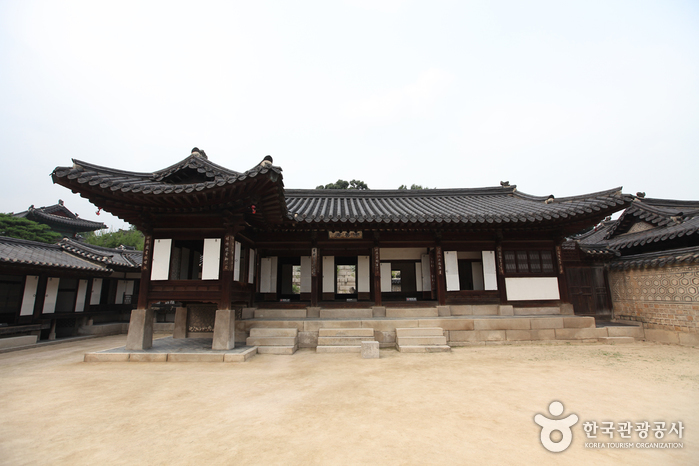Rawrow - Kwangjang Market Branch [Tax Refund Shop] (로우로우 광장시장)
7.1Km 2024-04-19
Store #239, Gwangjang Market, 88, Changgyeonggung-ro, Jongno-gu, Seoul
-
Bonafide Jewelry [Tax Refund Shop] (보나파이드주얼리)
7.1Km 2024-06-27
29, Itaewon-ro 54ga-gil, Yongsan-gu, Seoul
-
Nakseonjae Hall (낙선재)
7.1Km 2021-09-30
99, Yulgok-ro, Jongno-gu, Seoul
+82-2-2148-1822
Located inside Changdeokgung Palace, Nakseonjae Hall is a one-story structure built in ikgong style (bird wing-shaped eaves placed on top of the pillars) with a hip tiled and gable roof. It has 6 kan in the front and 2 kan (traditional unit of measurement of the space between pillars) to the sides. It originally belonged to the nearby Changgyeonggung Palace, but came to be considered a part of Changdeokgung Palace in more recent years.
The hall was constructed in 1846 (12th year of King Heonjong’s reign) and it is collectively called Nakseonjae together with the adjacent Seokbokheon Hall and Sugangjae Hall.
Behind the building is a flower garden made of stacked large stones. The chimney, the flowers, and the oddly shaped stones harmoniously blend into one another to create an outstanding landscape gardening.
Tailorable - Hannam Branch [Tax Refund Shop] (테일러블 한남점)
7.1Km 2024-04-23
2, Daesagwan-ro 7-gil, Yongsan-gu, Seoul
-
Monday Edition [Tax Refund Shop] (주식회사 먼데이에디션)
7.1Km 2024-04-23
1F, Store #1, Store#2 (Hannam-dong), 57, Daesagwan-ro 11-gil, Yongsan-gu, Seoul
-
Changdeokgung Palace Complex [UNESCO World Heritage Site] (창덕궁과 후원 [유네스코 세계유산])
7.2Km 2025-07-21
99 Yulgok-ro, Jongno-gu, Seoul
Changdeokgung Palace was the second royal villa built following the construction of Gyeongbokgung Palace in 1405. It was the principal palace for many kings of the Joseon dynasty, and is the most well-preserved of the five remaining royal Joseon palaces. The palace grounds are comprised of a public palace area, a royal family residence building, and the rear garden. Known as a place of rest for the kings, the rear garden boasts a gigantic tree that is over 300 years old, a small pond and a pavilion.
The palace gained importance starting from the time of Seongjong, the 9th king of Joseon, when a number of kings began using it as a place of residence. Unfortunately, the palace was burned down by angry citizens in 1592 when the royal family fled their abode during the Imjin War. Thanks to Gwanghaegun, the palace was restored in 1611. Even today, it houses a number of cultural treasures, such as Injeongjeon Hall, Daejojeon Hall, Seonjeongjeon Hall, and Nakseonjae Hall.
Changdeokgung Palace’s garden behind the inner hall, called the "Secret Garden," was constructed during the reign of King Taejong and served as a rest area for the royal family members. The garden had formerly been called Bugwon and Geumwon, but was renamed Biwon Garden, or Secret Garden, after King Gojong came into power. The garden was kept as natural as possible and was touched by human hands only when absolutely necessary. Buyongjeong Pavilion, Buyongji Pond, Juhamnu Pavilion, Eosumun Gate, Yeonghwadang Hall, Bullomun Gate, Aeryeonjeong Pavilion, and Yeongyeongdang Hall are some of the many attractions that occupy the garden. The most beautiful time to see the garden is during the fall when the autumn foliage is at its peak and the leaves have just started to fall.
Though it has been treasured by Koreans for centuries, Changdeokgung Palace and its complex was recognized as a World Cultural Heritage site by the UNESCO World Cultural Heritage Committee in December of 1997 during the committee meeting in Naples, Italy.
PLATFORM PLACE HANNAM[Korea Quality]/플랫폼 플레이스(한남점)[한국관광 품질인증]
7.2Km 2024-06-25
268 , Itaewon-ro, Yongsan-gu, Seoul
+82-2-797-4628
Platform Place Hannam store, located near Itaewon Street in Yongsan-gu, Seoul, sells a selection of overseas brand products, including clothing, household items and kitchenware, stationery, and other designer items. Over 50 brands are featured, including Saint James, Neul, Norse Projects, Blue de Paname, Homecore, and Rocky Mountain Featherbed.The shop is right next to Hangangjin station on subway Line 6, and customers can also use a pay-for public parking lot.
Passion 5 (패션5)
7.2Km 2024-03-08
272, Itaewon-ro, Yongsan-gu, Seoul
+82-2-2071-9505
Passion 5 is a bakery and dessert café located in an art gallery-like space. It is made up of four sections offering bread, cakes, chocolate, and coffee with their unique ambiences. The menu consists of nearly 300-400 dessert items drawn from baking traditions around the world, including cakes, pudding, and handmade chocolate.
![Rawrow - Kwangjang Market Branch [Tax Refund Shop] (로우로우 광장시장)](http://tong.visitkorea.or.kr/cms/resource/29/2878229_image2_1.jpg)
![Bonafide Jewelry [Tax Refund Shop] (보나파이드주얼리)](http://tong.visitkorea.or.kr/cms/resource/37/3314337_image2_1.jpg)

![Tailorable - Hannam Branch [Tax Refund Shop] (테일러블 한남점)](http://tong.visitkorea.or.kr/cms/resource/41/2890041_image2_1.jpg)
![Monday Edition [Tax Refund Shop] (주식회사 먼데이에디션)](http://tong.visitkorea.or.kr/cms/resource/77/2887777_image2_1.jpg)
![Changdeokgung Palace Complex [UNESCO World Heritage Site] (창덕궁과 후원 [유네스코 세계유산])](http://tong.visitkorea.or.kr/cms/resource/03/3092503_image2_1.jpg)
![PLATFORM PLACE HANNAM[Korea Quality]/플랫폼 플레이스(한남점)[한국관광 품질인증]](http://tong.visitkorea.or.kr/cms/resource/51/2627551_image2_1.jpg)
![Kasina [Tax Refund Shop] (카시나)](http://tong.visitkorea.or.kr/cms/resource/03/2891103_image2_1.jpg)

 English
English
 한국어
한국어 日本語
日本語 中文(简体)
中文(简体) Deutsch
Deutsch Français
Français Español
Español Русский
Русский